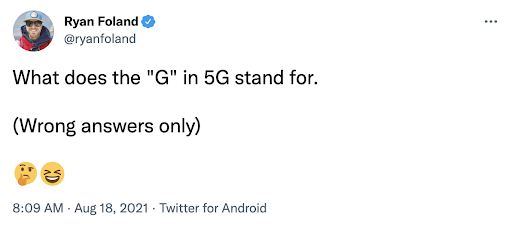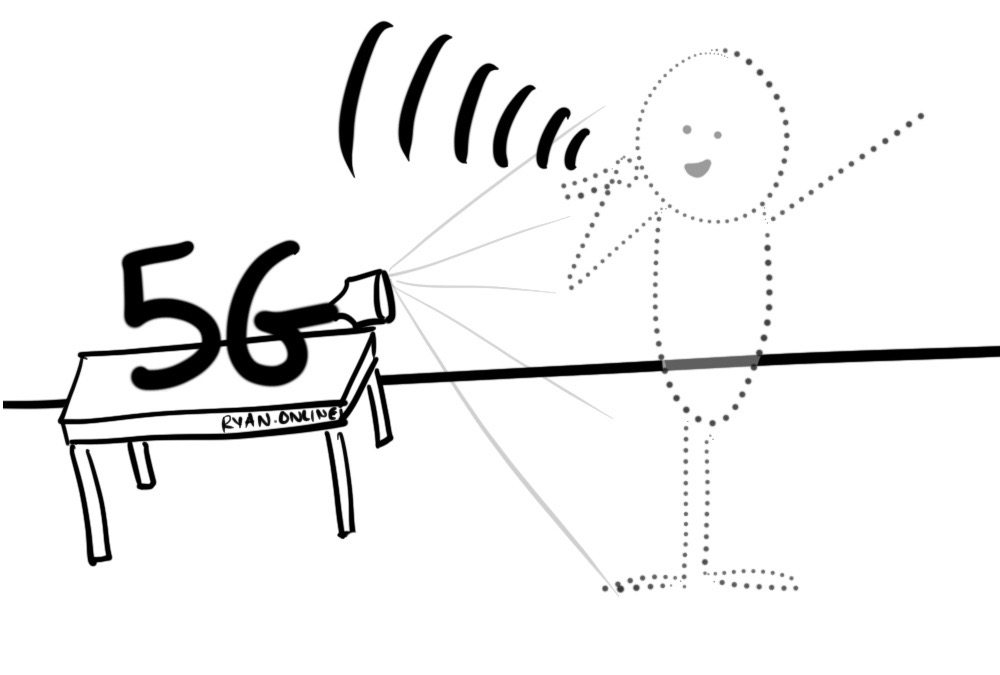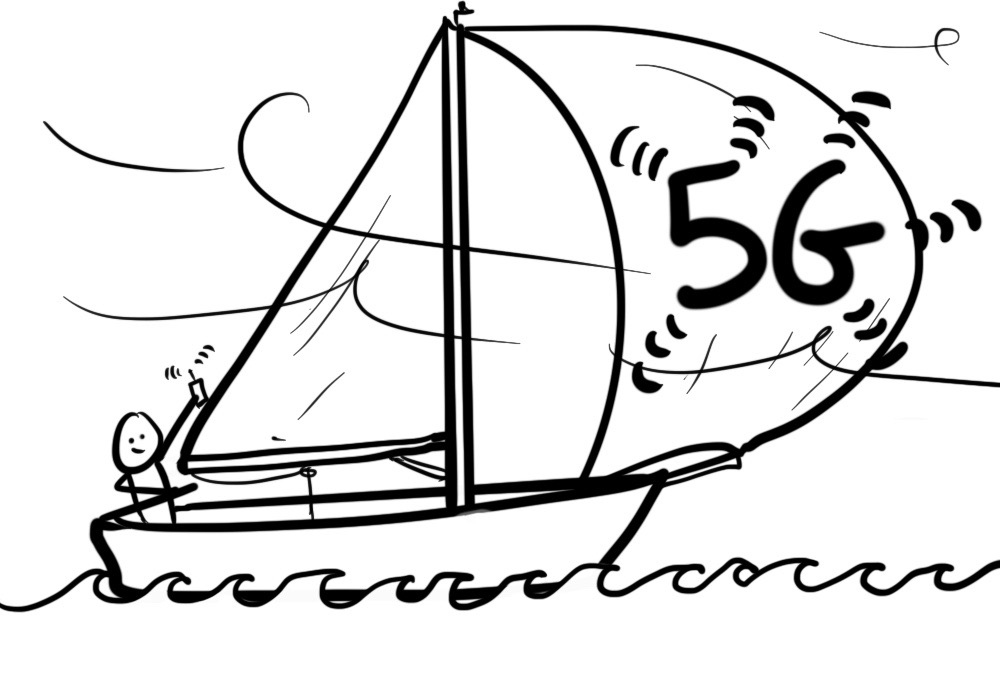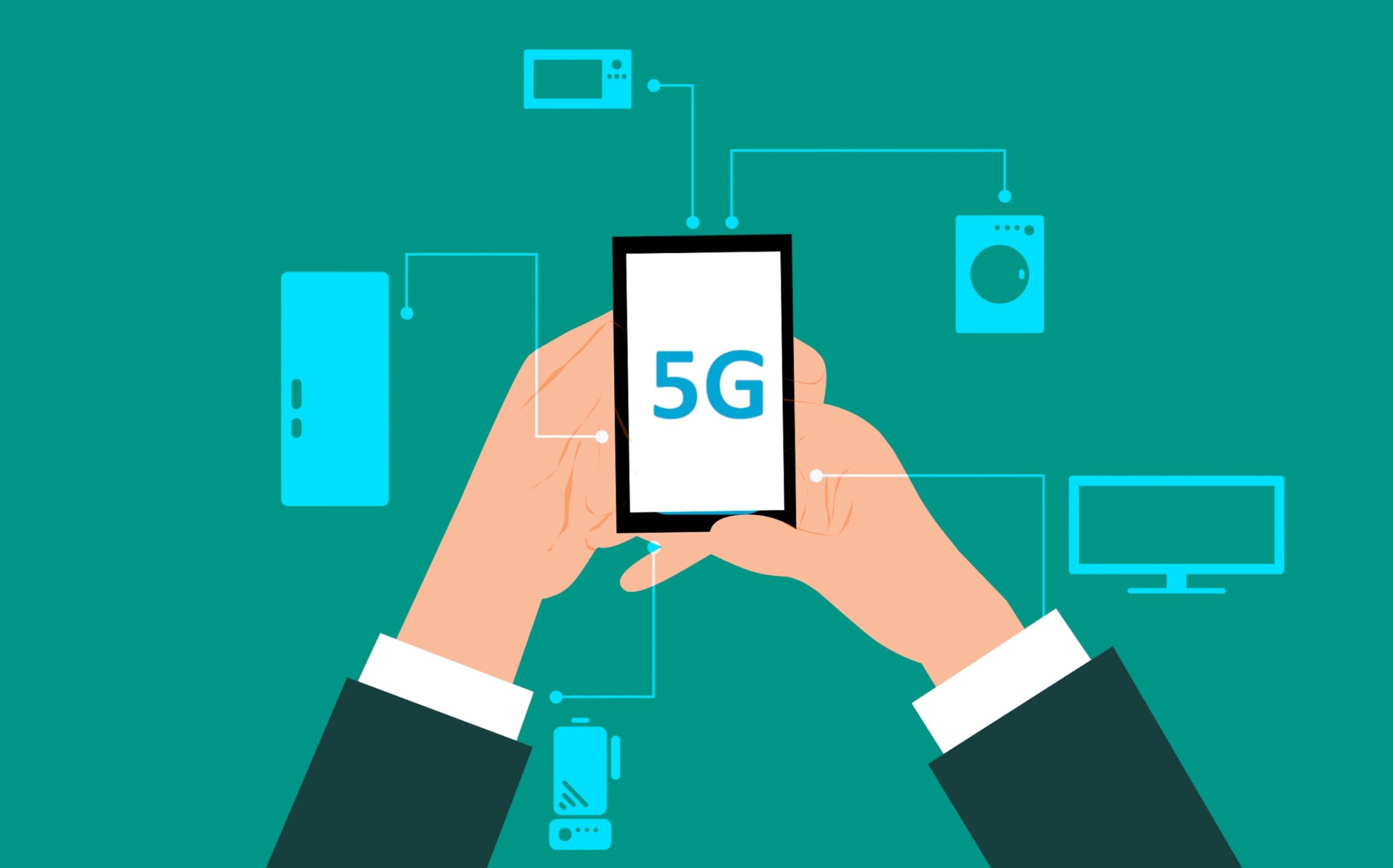In a recent tweet, I asked my followers what the G stood for in 5G. The fun part is that I asked for wrong answers only.

As of this writing, that tweet has had over 100,000 impressions and more than 2,500 engagements. Lots of fun GIFs and guesses.
As a result of my Twitter research, I can tell you for sure that the “G” in “5G’ does not stand for Goofus, Gigawatts, Goats, Gassy, Gelato, G-string, Gorillas, Geico, Giraffe, Gee-whizz, Gravy, G-Unit, Goblins, G-spot, G’day mate, Gravy, Gigantic, Granola, Geese, Grandiosity, Ghost, Gangsta, Guava, Garbage, Gyro, Gertrude, Gallons, Gravitons, Gatorade, or Gilligan.
The correct answer is that ‘G’ stands for Generation.
And “5G” means that it is the fifth major overhaul of our most modern cellular generation innovations. 1G enabled us to talk on phones that looked like bricks, 2G enabled us to text and call, 3G allowed for phones to be smarter, and 4G is what has allowed businesses like Uber and Netflix to become common household names.
5G Vocab:
- Speed – how quickly you can download data
- Latency – how quickly a signal gets from point A to B
- Bandwidth – the number of devices that can connect in a small area without loss of service
5G will deliver high bandwidth and low latency like never before, and this will enable many use cases, or applications of the 5G technology to bring new, smarter, and more efficient ways of doing business.
But the more I learn about 5G, the more I think it should have been named 5000G. The reason is that the jump from the fourth to the fifth generation does not do justice to 5G’s power.
You’ve likely seen or heard ads from your cellular provider about how 5G is the next big thing, and how it will give you and your phone the speed you need when it comes to connectivity. Eventually, the promises you are hearing will come true. For now, the real changes that are happening with 5G are the ones you don’t see, because they are in the form of private networks built by some of the biggest companies in the world
5G technology, as it relates to enterprises, is positioned to be the fuel for the 4.0 Industrial Revolution (Industry 4.0), and for that reason, it’s worth understanding all the hype.
Recently, I started working with Shabodi, a venture-backed 5G tech company that accelerates the development and deployment of next-gen applications on advanced networks such as 5G. They trivialize complex problems by offering a very elegant solution. Just the kind of project I like to be involved with.
As I am learning more about 5G and the rabbit hole of its applications and use cases, I am getting more and more excited about what I am finding. The pirate in me is convinced that “Thar be treasure in them thar applications.”
There is always value in catching a technology wave early. In the beginning, as things grow and expand, there is exponential opportunity. I see 5G as a technology that has the power to not only reduce latency and increase the quality of service (QoS), but it has the potential to unlock a new way of how we use and interact with technology. The way I see it, 5G is going to be a key enabler not only of next-gen applications but also gaming, NFTs, the metaverse, and Web 3.0, enabled by next-generation technologies revolving around immersive reality and IoS (internet of senses). Yes, AR/VR are web 2.0 terms.
Here are the five reasons that I have my eye on 5G, and why you should too.
- New business models

If you know me, you know how much I love startups and have a soft spot for entrepreneurs with big ideas. 5G not only improves productivity and responsiveness with greater bandwidth and lower latency, but it also can lead to some of the best new big ideas. With industrial uses for augmented reality, virtual reality, the Internet of things (IoT), sensors, and robotics, 5G allows for new ways to manage the way businesses fundamentally operate.
5G-enabled technology will create new business models, and lead to exciting innovations that will change the way that we interact with technology in the world (and the metaverse). This is a pretty big deal. If you look back historically, new generations of technology happen on average every 10 years and the world is ready for the next generation of mobile technology.
It’s exciting to watch startups, scaleups, and some of the biggest companies in the world start to unlock the powers of 5G. There is plenty of room for new big ideas and innovative use cases, so start to think about what the future could look like by using technology in new ways that we haven’t been able to before.
- 5G will power remote work

The pandemic forced many people to flex their remote working muscles whether they liked it or not. But now as the world enters into a new reality where remote work is the new normal, I’m excited to see 5G technology catch up to make the remote work experience nearly identical to the in-person experience.
With each advance in mobile technology, it’s easy to look backward and see how far we’ve come. The increase in demand for flexible and remote work will likely see steady growth. And I believe more and more employees will be open to flexible working arrangements.
But if you’ve ever been on a Zoom call in Catalina, in Big Geiger Cove, on a sailboat trying to connect and do business as usual, then you’ll recognize how difficult it is to work remotely if the connection is not seamless. This is exactly what happened to me this last summer as I flexed my remote working muscles on my sailboat out at sea, and on anchor in the middle of nowhere.
What excites me about 5G is that it will eventually allow us to access faster speeds, whether you’re on a sailboat, at your house in a metropolitan area, or while on the move. In business, communication is everything and it’s imperative to make it possible for remote workers to have easy access to a reliable connection 24/7.
- The metaverse and NFTs need 5G

The metaverse is a concept that has been around for a long time but is now becoming mainstream, especially with Facebook’s recent rebrand to Meta. If you haven’t read the headlines recently, the metaverse is essentially a virtual world created through the use of immersive technologies like augmented and virtual reality. The way I explain a metaverse to someone is to have them imagine a video game (think Minecraft). Essentially a metaverse is a digital environment just like a video game.
This metaverse could be some sort of sci-fi-based fantasy world, it could be a digital museum on Spatial, or it could be an almost exact digital duplicate of a redwood forest or a digital underwater world. There will be different metaverses for different communities of interest. The metaverse is a big part of Web 3.0, which refers to the next generation of how we interact with the internet. Right now it’s very two-dimensional, but with 5G and the unlocking of bandwidth-hungry AR in VR technologies, expect to see your internet experience become more three-dimensional. Whether you like the idea of it is a whole different story.
In the metaverse, people will have digital property, and digital items, from avatars, to outfits, to digital art. And all of the ownership will be through non-fungible tokens (NFTs), documented on the blockchain. There is a good chance you may have heard about NFTs on the news recently, or trending on Twitter. If you are curious to learn more, I recently wrote about how to create your own NFT.
It’s an interesting space, and I have had fun making my own NFTs. I have created projects like Sailing Adventures, Face Dancing, Getting Sticky with it, and even special illustrations from my book, Ditch the Act. If you need an excuse to buy your first NFT, I’m happy to be that excuse. I’ve got plenty of Stick Figure Art for you to pick from!
There is a lot to learn and understand about blockchain, NFTs, and cryptocurrency. Mark my words, 5G will be fuel for growth and mass-scale adoption of it all.
You will keep hearing about it on the news and social media, and it’s not going away anytime soon. For now, think of NFTs as a way to own digital property, which could be a GIF, digital image, an avatar, or even a digital piece of property in a metaverse. If it sounds like a lot, it is.
Don’t get intimidated, get interested. Start to read articles, like Brian Evan’s Forbes article about NFTs, or Gary Vaynerchuk’s video interview with Mark Zuckerberg about the metaverse, or follow my friend Mitch Jackson, who loves to talk about the legal aspects of it all. The information is out there. I’m digging in and learning too.
- 5G and the future of speaking

I’ll admit as a professional speaker that the move to digital platforms due to the pandemic stopped my business in its tracks. I was an early adopter at providing digital keynotes and was able to transition my workshops to a virtual environment, so I ultimately fared well in my pivot during the pandemic, all things considered. But I fundamentally look at the business of speaking in a whole new way, and I see 5G fueling the future of what it is to be a keynote speaker.
Eventually, when AR and VR technologies learn to take advantage of 5G’s added bandwidth, it can open up a new world for speakers and audiences alike. I can envision myself giving one of my high energy, interactive keynotes virtually, not through Zoom, but in the metaverse, where people from all over the world can put on their Oculus headsets and join in. The technology is here, but the networks have not been able to make remote attendees feel as if they’re in the same room. When that happens, you better believe it will make for some awesome presentations that are crazy engaging and interactive.
And if that is not cool enough, just wait until I show up at your business as a hologram ready to give a 3D presentation!
- 5G at sea

From saying “Ahoy” instead of hello, spending my summers on a sailboat, to helping launch the Good Jibes podcast with Latitude38, sailing is a big part of my life. It’s how I love connecting with nature. There is something magical about being pushed by wind through waves. I do admit, that when I’m out sailing I’m all about being offline. However, the idea of being able to be online while at sea with lightning-fast internet sounds pretty awesome. It would allow me to be connected if I wanted to. That way, I can really work from anywhere.
When it comes to the current state of 5G and the sea, unfortunately, it’s only available close to shore. But with visionaries like Elon Musk planning to launch hundreds of 5G-capable satellites, there’s a chance that soon the whole world can get connected to a super-fast network that powers the cloud on your phone and enables 5G smart devices on your boat anywhere in the world.
When you’re sailing, you have to go online and manually update your electronic charts. With 5G you can update your charts in real-time, and have uninterrupted access to huge amounts of cruising information built into your display and your phone. Right now the automatic identification system (AIS) alerts sailors to dangerous collisions so that we can safely move out of the way. With 5G (close to shore) your boat will be constantly talking to all of the boats and ships around you and it will communicate with the autopilot to change course to avoid any type of disaster. I like the sound of that.
The bad news about 5G when it comes to the sea is that there is an established concern, and the Department of Defense (DOD) has made an official statement claiming that 5G will interfere with Global Positioning System (GPS) services. And since GPS devices are a boaters’ best friend, that could cause a lot of safety issues out at sea. Even with a warning from the DOD, the Federal Communications Commission (FCC) approved new 5G cellular networks that could interfere with boaters using GPS. The conversation is ongoing, and I hope that there can be a resolution that does not put boaters at risk.
Conclusion
The way I see it, we’re in the early days of a revolution.
But let’s not pack our bags just yet. I’ve also learned that there are a lot of mismanaged expectations about the migration to 5G. It’s not as easy as flipping a switch from 4G applications to 5G, and it’s expensive. If the transition is not done correctly, enterprises won’t get the full value out of the new technology.
Closing this gap will make the difference between winning at 5G in the US. And that’s why I’m excited to be part of the solution with Shabodi. Using an application enablement platform (AEP), they provide developers with the ability to interact with their 5G network, in a way developers have never been able to do with previous wireless iterations. AEPs have more influence over the latency, bandwidth speed, QoS, packet flow, etc., of their applications. Imagine what type of applications one can envision and build when you can modify network behavior when deploying applications on a 5G network.
Think of the evolution to 5G as a digital gold rush. There is gold out there in new applications that will be built, but developers need the right kind of tools. The smart money that was made in the gold rush, was made by those selling the shovels, pickaxes, and pans. Similarly, I see what Shabodi offers to enterprises looking to leverage 5G as the digital version of today’s shovels, pickaxes, and pans.
5G is a revolutionary force, but be aware that it is still evolving. The most exciting use cases are yet to come, and to me, that is why this is all so intriguing. And whether you are intrigued or not about the future that 5G will unlock, mark my words that when you look back 10 years from now, things will look very different. If you want to take about the future of 5G as you see it, then Tweet me, and let’s geek out.
This is a Contributor Post. Opinions expressed here are opinions of the Contributor. Influencive does not endorse or review brands mentioned; does not and cannot investigate relationships with brands, products, and people mentioned and is up to the Contributor to disclose. Contributors, amongst other accounts and articles may be professional fee-based.

